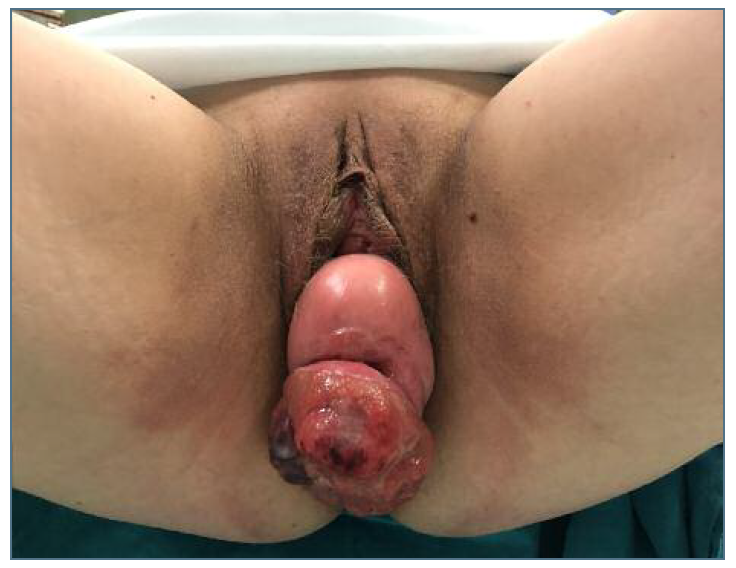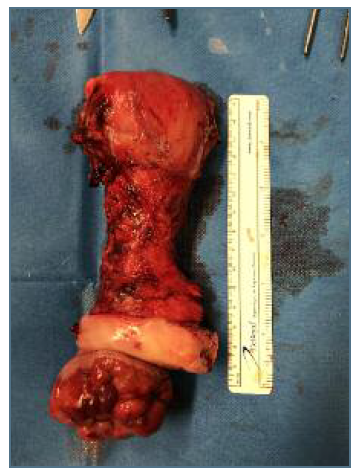Uterine prolapse and cervical elongation can co-occur due to several mechanisms: first, the prolapsed uterus could have had longer cervix; second the descent of the developing prolapse can induce cervical elongation through downward traction1. Also, growing cervical massess can drag the cervix, predisposing to cervical elongation and prolapse2.
Cervical fibroid usually manifests as a solid-bulky cervical mass with smooth surface. However, in some cases the fibroid can degenerate or erode, fragilizing the surface, leading to bleeding and necrosis3.
We present a case of cervical fibroid with cervical elongation resembling malignancy.
A 46-year-old woman, Gravida 1, Para 1, was referred to a gynecology appointment for a presumed non reducible uterine prolapse. Her medical or surgical history was unremarkable, and she was under no medication.
The patient reported a history of daily metrorragy and a progressive growing mass protruding from the vagina, over the past 4 months.
Clinical examination confirmed the presence of a nontender cervix with a protruding exofitic mass with 10 cm coming from the posterior lip of the cervix with necrosis (Figure 1). Vaginal examination showed well positioned vaginal pouches and an apparent hypertrophic elongation of the cervix, occupying the entire length of the vagina.
Transvaginal ultrasound revealed a nonprolapsed augmented-sized uterus (120x52x63 mm).
A biopsy of the lesion was performed, revealing fragments with fibrinoleukocyte exudate and fibroconnective stroma, and no signs of malignancy.
The patient was admitted for surgical excision. During admission, further enlargement of the protruding mass with bleeding and ischemic-type areas was observed. A Laparoscopy-assisted vaginal hysterectomy (LAVH) was performed because it was the easiest approach, as the uterus was non-prolapse, allowing for bilateral salpingectomy. (Figure 2).
Post operative period was unremarkable and the patient was discharged on the following day.
Histopathological examination confirmed the diagnosis of a cervical leiomyoma, exocervical hyperplasia without atypia and extensive ulceration.
Growing cervical masses can drag the cervix, predisposing to cervical elongation and prolapse. Diagnosis of prolapsed cervical leiomyomas can be challenging, as pelvic examination may not be able to exclude a uterine prolapse or a uterine inversion4.
Moreover, in our case, clinical presentation was mimicking a cervical malignancy, as it presented as a fragile cervical mass with some bleeding and necrosis.
Cervical fibroids protruding through vagina are usually pedunculated. Nevertheless, in our case, the fibroid was not pedunculated, presenting as a bulky mass on the cervical tissue, mimicking a cervical malignancy. Thus, biopsy is compulsory to establish the diagnosis and to guide the decision-making process. As our preoperative biopsy did not show signs of malignancy, our approach was vaginal. Manchester Fothergill is considered an affective procedure for cervical elongation without pelvic organ prolapse since it allows shorter surgery length and less surgical complications, compared to vaginal hysterectomy5.
In our case, the patient expressed a desire to underwent hysterectomy and for that reason we chose to perform a LAVH.
We highlight this case because of the atypical presentation of cervical elongation with cervical fibrinoids, without uterine prolapse associated, with rare cases found on the literature.
Authors’ contribution
Conceptualization: Marília Freixo, Anabela Melo, Sílvia Torres
Methodology: Marília Freixo
Writing - Original draft: Marília Freixo
Writing - Review: Marolia Freixo, Anabela Melo, Sílvia Torres

















